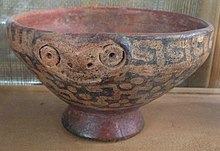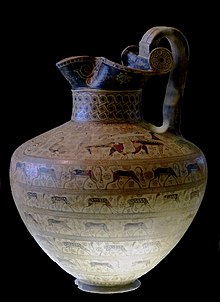



Negative painting is done by painting the background of a design dark, allowing the lighter color to appear as the design. It is an important technique in the history of decorating pottery. It has also been labeled "lost color".[1] There have been at least four methods proposed as to how negative painting was done.[2] It is widely found on painted pottery, but it is speculated that “the first objects with negative painting may not have been pottery, but rather textiles or gourds.”[3] The term "negative painting" is also used by artistic painters, particularly with water color paints.
Historically, it was created and used most widely in the New World. "Arguments for the theory that negative painting was developed only once and spread from its point of origin are more numerous and more convincing."[4] Robert Stigler believed that in the New World, it was first done on the south coast of Peru.[5] Then, he believed, it spread northward, with examples found in Ecuador, Meso-America, and the USA. In the USA, it is most commonly found in the southeast, from Florida to Ohio to Illinois to Texas”,[6] but it is not believed that it originated there.[7] One example of negative painting on pottery has been found in Wisconsin, but it is assumed to have travelled there by trade, not to have been locally produced.[8]
Others are not so sure about this scenario: “When and how the negative painting technique became part of craft traditions in North America is still unclear. The method may have been introduced via diffusion through Mexico or could have easily been an independent invention.”[9] Curry lists a variety of scenarios that have been proposed for the creation and diffusion of negative painting on pottery, including the proposal that it was carried across the Caribbean to the mouth of the Mississippi and was diffused from there.[10] “Negative painted pottery (NPP) is one of the most distinctive kinds of pottery made by Mississippian culture during the Middle Mississippian period (ca. A.D. 1200-1500) in eastern North America.”[11]

There have also been examples of negative painting on pottery in Colombia and on the north coast of Brazil near the mouth of the Amazon. There are also examples of negative painted pottery from the ancient Mediterranean, from Italy[12] and Miletus and Rhodes.